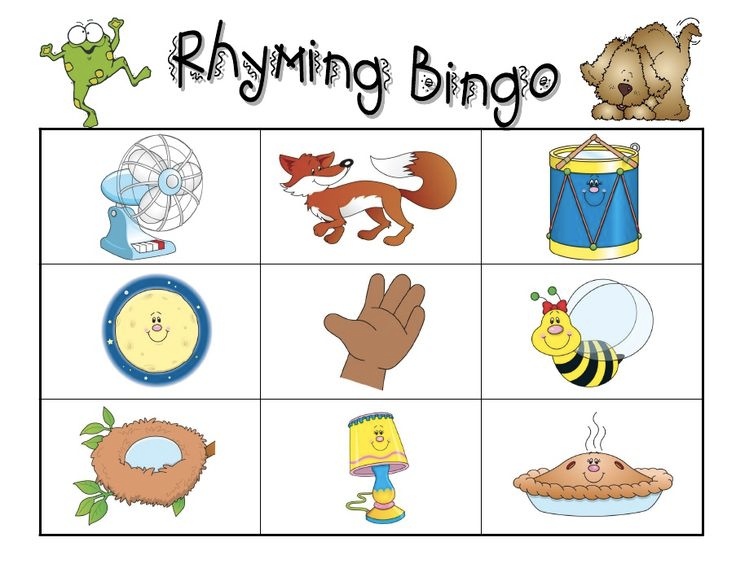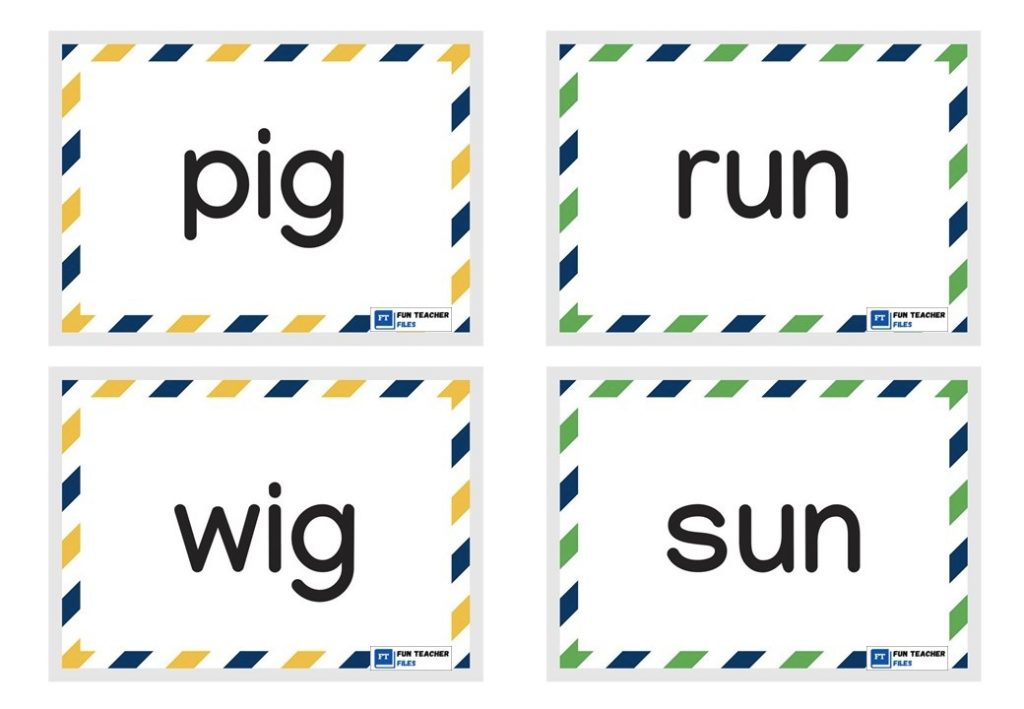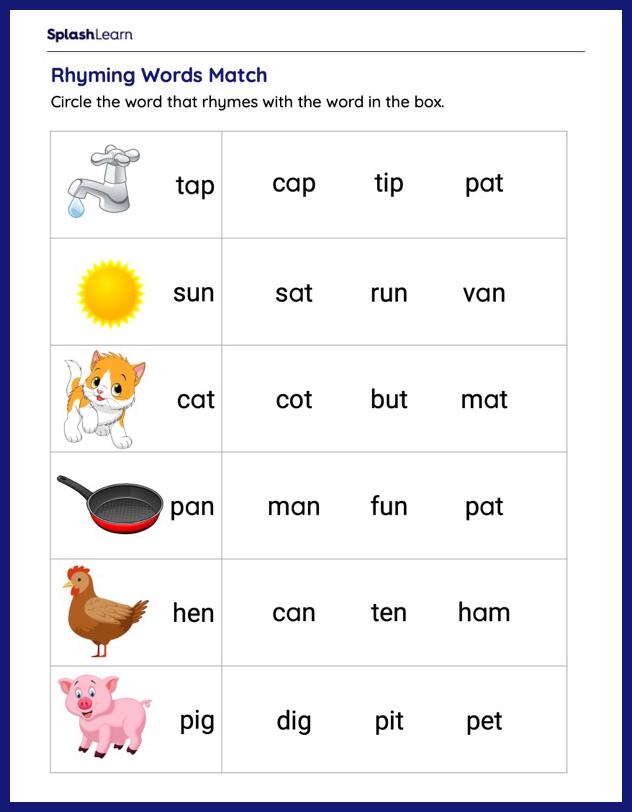Did you know that teaching rhyming words is crucial in developing phonics skills in kids? When children engage with rhymes, they practice identifying and producing words that end with the same sounds. This skill is critical as it enables them to understand that words are made up of smaller sound units. By mastering rhymes, children learn to anticipate the structure of new words, making it easier to decode and spell them as they progress in reading.
Math & ELA | PreK To Grade 5
Kids see fun.
You see real learning outcomes.
Watch your kids fall in love with math & reading through our scientifically designed curriculum.
Parents, try for free Teachers, use for free
This blog will explore the stages of teaching rhyming words and share 15 fun ways to introduce this essential skill to kids.
What are the 3 Stages of Rhyming?
1. Hearing and Recognizing Rhymes
The journey to teach rhyming words begins with children learning to hear and recognize rhymes. This first stage is all about tuning into the sounds of language. Through listening to songs, poems, and stories filled with rhymes, children start to notice the patterns that make words sound alike. This exposure is crucial because it lays the groundwork for all the following rhyming skills.
Here are some fun rhyming word games where kids get to listen and master the words:
2. Producing Rhymes
After children become familiar with hearing rhymes, they produce their own. This stage is a significant milestone in teaching rhyming words because it shifts from passive listening to active participation.
Initially, kids might need some help through guided activities, but soon they begin to invent rhymes independently. Encouraging children to play with words and develop their own rhyming pairs can be a lot of fun. Simple prompts and games can spark their creativity and make learning enjoyable.
3. Understanding and Applying Rhymes
The final stage is when children grasp the concept of rhyming words and how to apply this knowledge in various contexts. This understanding signifies a deep comprehension of how language works. At this point, more complex activities and games play a crucial role in reinforcing their skills. By engaging in diverse and challenging tasks, kids learn to use rhymes in new and creative ways, solidifying their learning and preparing them for more advanced language and literacy concepts.
You can start practicing with these fun games:
12 Fun Ways to Teach Rhyming Words
1. Online Rhyming Games
Incorporate online rhyming games into your teaching tools to make learning dynamic and engaging. These games provide interactive challenges where children listen to words, identify rhymes, and select words that don’t fit the rhyming pattern. For instance, in “Odd Word Out,” kids hear a list of words and must click on the one that doesn’t rhyme with the others. These activities make learning fun and reinforce auditory discrimination and phonological awareness, critical skills in early reading development.
2. Fill-in-the-Blank Rhymes
To teach rhymes to kindergarten kids effectively, consider a fill-in-the-blank activity with word families. Provide the children with a list of words ending in dashes, where each belongs to a specific rhyming family, such as “-ug”. Ask the kids to complete words like “b_g” or “t_g” with rhyming endings to form words like “bug” or “tug”. This exercise not only enhances their understanding of rhyming sounds but also helps them recognize patterns in word formation.
Get started with these fill in he blanks worksheets:
3. Match and Trace
Teach children about different rhyming word families through tracing and matching exercises. For example, word families like “-at,” “-ug,” and “-ip” can be included with words such as “cat,” “bug,” and “dip.” Each word will be on one side of the worksheet for tracing to practice handwriting skills. On the opposite side, there will be pictures corresponding to each word. After tracing, children draw lines to connect each word to its matching picture.
This activity not only reinforces the sounds and spellings of the words but also enhances visual recognition and understanding of rhyming patterns, offering a comprehensive learning tool.
Here are some fun matching and tracing worksheets to get started:
4. Color the Rhymes
If you are looking to teach rhymes to preschoolers, rhyme coloring can be a fun activity for them. Kids are presented with a list of multiple words. The task is to identify and color the words that rhyme with a specific word family. For instance, if the focus is on the “-at” family, the worksheet will feature a variety of words, and children must color words such as “mat,” “hat,” and “rat” while leaving non-rhyming words uncolored.
This activity helps children visually distinguish rhyming words from others, reinforcing their understanding of phonics and rhyming schemes. The act of coloring also makes the learning process enjoyable and memorable, aiding in the retention of rhyming patterns.
Here are some fun rhyme coloring worksheets to get started:
5. Word Family Wheel
Kids are presented with a wheel containing various letters. The goal is to use these letters to form words that belong to specific rhyming word families. For example, the wheel might include letters that can form words in the “-at,” “-ug,” “-in,” and “-en” families. Children will use the letters and then to create words like “bat,” “rug,” “pin,” or “hen” . This activity encourages kids to think critically about how words are constructed and enhances their ability to recognize patterns in phonics
Here are some fun word family wheel worksheets to get started:
6. Circle the Rhymes
Kids are given a primary word and a list of multiple corresponding words. Their task is to carefully read through the list and circle the words that rhyme with the given primary word. For example, if the primary word is “log,” the list might include “dog,” “cat,” “frog,” and “mat.” Children must identify and circle “dog” and “frog” as the rhyming words.
Here are some fun rhyme coloring worksheets to get started:
7. Matching Games
A matching game is an effective method for introducing rhyming words in a fun setting. The worksheet will feature columns of words along with pictures that correspond to each word. Some words and pictures will rhyme with others on the page, such as “sock” and “clock.” Children are tasked with drawing lines to connect words to their rhyming partners or to the corresponding rhyming pictures.
Here are some fun rhyme-matching worksheets to get started:
8. Rhyming Books
Rhyming books are a fantastic starting point when introducing rhyming words to young learners. Classic books by authors like Dr. Seuss are filled with playful rhymes that help children recognize sound patterns in a fun way. While reading, emphasize the rhyming words by pausing and allowing the children to guess the next rhyme. This interactive approach enhances their ability to hear and produce rhyming sounds.
9. Rhyming Songs
Teaching rhyming words to kindergarten can be joyful with the use of rhyming songs and nursery rhymes. Engage the children by singing songs such as “Twinkle, Twinkle, Little Star” and ask them to listen carefully and clap when they hear rhyming words. This method helps them tune in to the rhythm and patterns of language, making it easier to understand how rhyming works.
10. Rhyming Bingo

Rhyming Bingo is an interactive game that teaches rhyming words through play. Create bingo cards with pictures of rhyme items, such as “cat” and “hat.” Children will identify and cover the rhyming pictures on their cards as you call out words. This game reinforces rhyming skills because it requires children to actively think about and recognize rhyming pairs.
11. Rhyme Creation
One of the best ways to teach rhyming is by encouraging children to create their own rhymes. Start with a simple word like “dog” and ask the children to think of as many rhyming words as they can, like “log” or “frog”. This activity not only builds vocabulary but also lets them experiment with sounds, fostering creativity and phonemic awareness.
Related Reading: Best Grade-Wise Phonemic Awareness Activities for Kids
12. Rhyme Flashcards

Rhyme Flashcards is a simple yet powerful tool to practice rhyming words. Start by showing a flashcard with a single word to the children. Then, prompt them to say aloud or find another word that rhymes with the one on the card. For instance, if the flashcard says “cat,” the children could respond with “hat,” “bat,” or “mat.” This activity enhances their ability to quickly generate rhyming words, reinforcing their understanding of sound patterns and boosting their vocabulary.
Related Reading: Best Tongue Twisters for Kids
Conclusion
Teaching rhyming words through engaging activities like worksheets, matching games, and interactive online platforms is an effective way to develop early literacy skills. By exploring these varied methods on how to teach rhyming words, you can provide children with the foundational skills they need for reading and language development, ensuring that learning remains both fun and fruitful.
Related Reading: How to Teach Vowels to Kids: A Step-by-Step Guide
Frequently Asked Questions (FAQs)
What order do you teach rhyming words?
Begin teaching rhyming words by introducing simple and familiar words, progressing from monosyllabic words in short word families like “-at” or “-an” to more complex multisyllabic rhymes. This gradual approach helps build confidence and understanding.
What is the purpose of teaching rhyming words?
The purpose of teaching rhyming words is to enhance phonemic awareness, which is crucial for reading and spelling. Understanding rhymes helps children recognize sound patterns and syllable structures in words, aiding in their language development.
What are some rhyming techniques to keep in mind?
When teaching rhyming skills, it’s effective to use repetition, incorporate musical elements like songs, and engage children with interactive games. These techniques make learning rhymes more enjoyable and memorable, representing the best way to teach rhyming.

























































